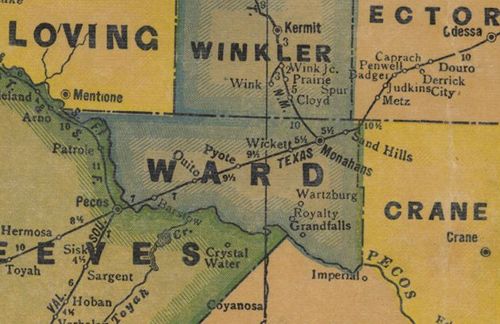|
|
Quito
by Mike
Cox
The town site would have been located in Section 143
along the Texas & Pacific Railroad, about five miles east of Barstow.
|
|
The
ghostliest of ghost towns
are those that existed only on paper as blocks and lots on a grid
of never-graded streets crisscrossing an un-realized dream.
And surely one of the least known was Quito, Texas, not to be confused
with the city of 1.5-plus million that is the capital of Ecuador.
Unlike Shafter,
Thurber
or scores of other Lone Star
ghost towns, Quito has no picturesque ruins. It doesn’t even have
a bullet pock-marked historical marker. All that remains of Quito
is a piece of paper filed away in the deed records of the Ward
County clerk’s office in Monahans
and a scattering of purple glass fragments, china shards, rusty railroad
spikes and other detritus left at two long-gone railroad stops.
W.P. Luce, Fort Worth
entrepreneur and future oil man and Texas A&M University benefactor,
filed a plat map of Quito Town on May 8, 1911. According to the document,
recently unearthed by C.B. Wilson of Dallas,
the town site would have been located in Section 143 along the Texas
& Pacific Railroad, about five miles east of Barstow.
The
town plan showed 14 named streets running north to south (Wagner,
Church, Railroad, Plain, Dugas, Commerce, Main, Pecos, Roosevelt,
Ward, Texas, Magnolia, Long and South) and the same amount of numbered
streets from east to west.
Wilson, who owns the multi-section ranch that includes where Quito
would have been, found the plat while looking for more documentation
on his family’s holdings. He hopes the map can be restored for posterity’s
sake, since it’s nearly a century old and documents a town that never
was.
Well, it sort of was. Quito and Quito Wells (also shown
on railroad maps as Quito Water Station) were, respectively,
a section house and water stop on the T&P when tracks came through
that part of West Texas
in 1881. As recently as the 1950s, Quito continued as a flag stop
for both passenger trains and buses. But the railroad abandoned the
facilities years ago and no structures remain today.
In the early days, however, the railroad
maintained points at regular intervals along its trackage for water
stops (to accommodate steam-powered trains) and workers who handled
track maintenance along their section, usually six miles of rail.
By the T&P’s reckoning, Quito Water Station lay 630.69 miles west
of Texarkana,
the point where the line entered Texas,
and the Quito town site was 3.6 miles west of the wells.
So
why would anyone want a town that then and even now is miles from
anywhere?
The answer is what could be found another 2.3 miles west of Quito
– a
quarry developed by the railroad to capitalize on an outcropping
of Santa Rosa sandstone more popularly known as Pecos red sandstone.
That long-abandoned quarry, once 70 feet deep but now partially filled
with sediment from a rare torrential rain, produced stone that built
courthouses and business buildings across the state. One of the better
known of the surviving structures is the ornate Ellis
County courthouse in Waxahachie.
On paper, Quito covered a full section, 640 acres, with some 6,000
lots. In examining the deed records, Wilson found that 325 people
purchased lots between May 1911 and January 1915. Of those, 266 persons
bought individual lots, with the others buying multiple lots. Harry
D. Woodward of Denver, who if nothing else must have been an eternal
optimist, bought 1100 lots for $18,000 – big money back then.
Wilson did not recognize any Pecos,
Barstow
or Pyote family names
among the buyers, noting no sales to anyone from Ward
or Reeves counties.
“It seems pretty clear that the sales were to far away places and
hyped on some level because the locals were not participating,” Wilson
said.
Based on other town site promotions Wilson has seen in old newspapers,
Luce had salesman operating on commission who did road shows touting
the investment virtues of Quito. The farther from Ward
County, the better the sales. W.F. McCool of Sedgwick County in
Kansas bought 60 lots.
Prices ranged from a low of $5.50 a lot to $100 a lot. The quarry
west of Quito soon ceased operations and the planned town went nowhere.
While Luce and his agents made have made some money on the deal, the
various buyers did not. Eventually, Wilson’s grandfather acquired
the section and added it to his ranch holdings.
Why the railroad chose Quito as a place name remains a matter of speculation.
Quito is Spanish for “remove,” “take off,” “take away” and other variants.
Maybe someone came up with that name in relation to the quarry and
the ongoing removal of sandstone from it. No matter, it’s a fitting
name for a development that saw a lot of people’s money “quito-ed.”
© Mike Cox
"Texas Tales" April
2 , 2009 column |
 |
|
Ward
County
1940s map showing
Quito west of Barstow
on
the
Texas & Pacific Railroad
From Texas state map #4335
Courtesy Texas General Land Office
|
| Texas
Escapes,
in its purpose to preserve historic, endangered and vanishing Texas,
asks that anyone wishing to share their local history, stories, landmarks
and vintage/historic photos, please contact
us. |
|
|
